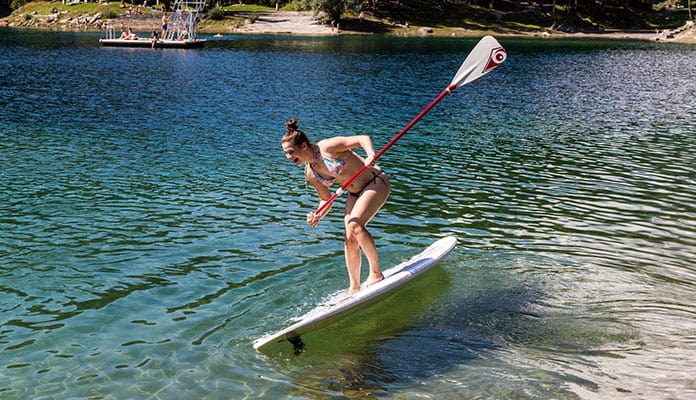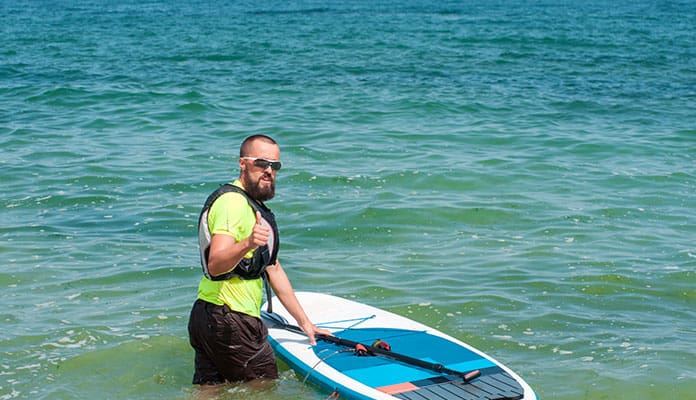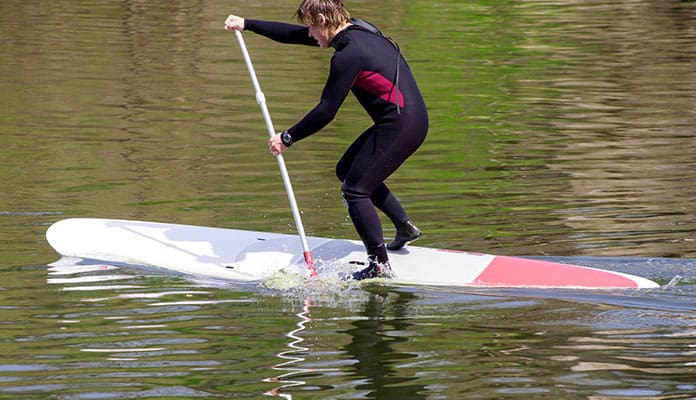
Stand up paddle boarding (SUP) appears serene when professionals practice it. It offers an unparalleled full-body workout whether it’s practiced for sport or pleasure. The toughest part of practicing this sport lies in the beginning since achieving balance can be arduous at first.
You must remember that even the pros fall off now and again even when they make SUP look peaceful and easy. They were beginners once too and probably fell as often as most beginners who attempt this water sport does.
As with most other water sports, you should always make sure that you wear a life jacket- ideally, one that isn’t too bulky. Even if you’re an experienced swimmer, unforeseen accidents can occur and it is always better to be safe than sorry.
The Wobble
One key aspect that connects novices to experienced paddleboarders is falling off; One main difference is, experienced paddle boarders know how to fall. It all starts with a wobble- suddenly your fight and flight instincts kick in. Do you try to regain your balance or do you fall off? Luckily, the more experienced you get, the easier it will be to recognize the severity of the wobble.
It’s actually recommended that you practice falling off a paddle board before you try and master the art of paddle boarding. Remember, it’s more important that you don’t get injured and get a second chance than risking it all for your pride.
The Fall
So now you’ve slipped off your board and gravity has taken over. Is there anything you can do? Yes. Remember this training: fall away from the board so as not to slam into it on your way down- you fall through the water, not paddleboards.
Once you’ve mastered falling away, you can move onto step two: fall as flat as you can while maintaining a slight decline in your feet. Now, step two can be tricky for two reasons- fall too flat, and risk a skin scorching belly flop; fall with too much of an incline or decline, and you may find out how deep the water is in the worst possible way. A good tip is to simply lie flat and point your toes down so they break your fall and help you slide into the water without plunging in too deep.
Remember, if you’re close to the shore, a belly-flop won’t make your ankles popping. In deep water, plunge only if you can come back up. Another reason plunging can be dangerous is a board strap.
While effective, board straps tie your ankle to the board, if you plunge feet first, chances are you’ll end up high-fiving the board with your whole body on the way down. If you have a board strap, be sure to jump away from the board and lie flat on the way down to avoid slamming your Achilles heel and/ or heel on your paddleboard. Ouch.
The Climb
 By now, you’re either underwater swimming back up or treading to keep yourself afloat. The next step is to locate your board and grab onto the board’s carry handle. If you have a board leash, you can use it to help you find your board quickly.
By now, you’re either underwater swimming back up or treading to keep yourself afloat. The next step is to locate your board and grab onto the board’s carry handle. If you have a board leash, you can use it to help you find your board quickly.
To begin your ascent back onto your board, tread next to your board, and use your less dominant hand to grab onto the carry handle. Then reach over the board until you can latch onto the opposite rail with your stronger, more dominant hand. Finally, kick the surface water behind you (your legs should be floating on the surface before doing so) and try to slide your belly on the board.
You should be halfway on the board by now at which point it is important to remember not to let go of the board until you are balanced and the water calms.
One crucial detail is, NEVER try to sink one side of the board and hop onto your paddle board- the water will act as a slingshot and shoot the board into the air. Objects that float tend to like being above the water and, given the chance, even a Styrofoam kickboard can cause serious injuries when slung onto someone’s head- paddle boards tend to be harder than Styrofoam kickboards.
You might also like: A Beginners Guide To SUP Surfing
Your Gear
After practicing personal safety techniques for falling off your paddle board, you can now think about your paddle. Did you toss it when you fell? Are you still holding on to it? Unsure? Chances are, the first few times you fall, your paddle will end up further than arm’s length away from you.
You’re now in the water, treading, and you suddenly think about your paddle. Step one: make sure you are safe and uninjured from your fall, in short, climb back on your paddle board. Now you are elevated, safe, and can afford to worry about your paddle.
Step two: locate the paddle, lay your belly on your board, and front crawl towards your paddle. When you are retrieving the paddle from the water, remember to lay on your belly while reaching for it instead of kneeling or squatting as this can cause another fall.
Have Fun
Now that you know how to stay safe while falling, you should actually practice falling: on purpose. It may seem weird at first, but you will eventually have fun imagining and creating scenarios for yourself that can cause you to fall off.
You’ll know you’re ready to practice bettering your paddleboarding when your instincts start mimicking your preparations for falling- basically when falling safely becomes second nature for you. Paddleboarding is a very popular sport that may seem scary at first, but once you get past the balancing aspect, it becomes fun, peaceful, and beautiful.
Globo Surf Overview
This sport will also teach you a lot about yourself especially your body and mind since your motor skills tend to be strained while learning to balance. You will also learn how your body can detect and adapt to slight breeze changes to keep you balanced and in control of your board. Paddleboarding, like life, has its ups and downs- the measure of your character is based on your ability to get back up on that board and laugh it off.
Skills Paddle Board Guides:
- SUP Deck Rigging Guide
- How To Choose The Right Paddle Board Size
- How To Teach Your Dog To Paddle Board
- How To Convert A SUP Into A Kayak
- How to Transport Your Stand Up Paddle Board
- Make Your Own SUP Paddle
- SUP Fitness: How Many Calories Does Paddle Boarding Burn?
- SUP Training Exercises


